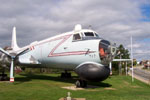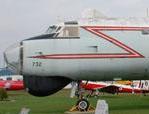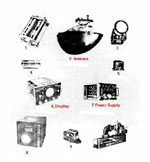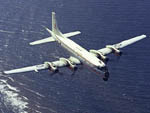ARGUS AIRCRAFT- ELECTRONICS FIT
INTRODUCTION
The RCAF.com web site provides this excellent summary of the
Argus aircraft.
The Canadian-built, Canadair CL-28 Argus was a unique hybrid
that employed the wings, tail surfaces and undercarriage of the British
designed Britannia transport, married to a completely new unpressurized
fuselage of Canadian design and equipped with different, but American-designed
engines.
Work on the CL-28 began in April 1954 and at the time it was the largest
aircraft built in Canada. The first CL-28 came off the assembly line on
December 21, 1956, flew on March 28 1957. It was delivered to the RCAF
in September 1957 where it was designated the CP-107. Thirty three were
originally delivered and all played out their service life in a maritime
role. The Argus entered service with the RCAF in 1958.
Argus was delivered in two variants:
Argus Mk 1 was fitted with the American APS-20 radar in a chin-mounted
radome. (13 built)
Argus Mk 2 was fitted with a British ASV-21 radar in a chin-mounted
radome. (20 built)
Other than the radar, there were no differences in nav, comms, or additional
ESM antennae above the fuselage between the Mark 1 and 2. All aircraft
underwent the same modification programs at the same time. The only aircraft
that was 'different' was the bird that Maritime Proving and Evaluation
Unit (MP&EU) used for project trials and evaluations, and generally
speaking that equipment was installed on a temporary basis. The blister
on top of the aircraft just behind the cockpit was intended for the ESM
DF antenna but never installed.
The Argus replaced the Neptune aircraft types previously flown in maritime
roles and eventually the Argus itself was to be replaced by the CP-140
Aurora aircraft in 1981.
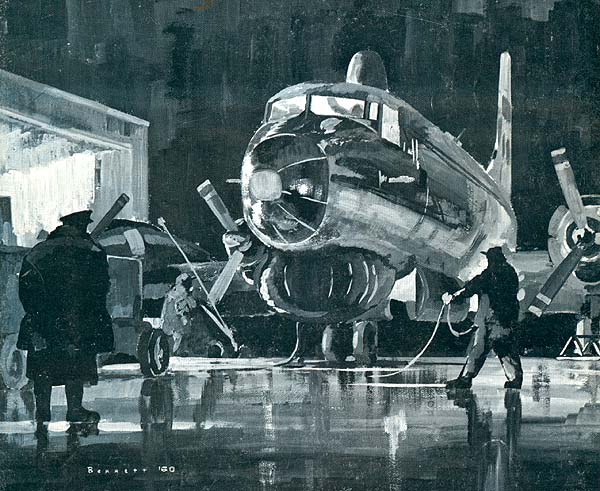 |
| In a scene that was repeated thousands of times, artist Captain Geoff
Bennett of 404 Squadron, Greenwood N.S captures an Argus just at the moment
prior to the start of engines. Depicted are the fire extinguisher man,
the ground man fiddling with his intercom cord and the sergeant standing
in a supervisory pose. (From Sentinel Magazine, May 1968) |
Manufacturer: Canadair license-built version of Bristol
Britannia.
Entered service : Sept 1957. 405 Squadron was the first
to convert from the Neptune to the Canadair Argus in 1958. 404 Squadron
converted to the Argus the following year. In May 1961, 415 Squadron was
reactivated at Summerside, PEI end began flying the Argus on North Atlantic
anti-submarine patrols.
Last year delivery: 1961. S/N #33 was stricken off strength
in 1982.
Crew: A standard crew was 16: 3 pilots, 2 flight engineers,
3 navs and 8 radio operators (RO's) but this could vary. The number
of RO's frequently got whittled down due to lack of personnel and sometimes
crew would have to be borrowed if somebody was sick or on leave.
There were seats for 25 which got used if the aircraft was going on a deployment
(typically 10 ground crew). The mid-section rest area could be configured
to carry cargo or seats. Originally, four bunks were stacked, 2 either
side of the isle, with an open space behind and between the over-wing escape
hatches. Sometimes the number of crew could vary depending on the Squadron
manning situation. Frequently, the Argus flew with only 6 RO's, occasionally
with 4 Navs (one under training), and then there might be a check pilot/FE/Nav/RO
along for annual recertification purposes.
Each 'trade' took each station in rotation, with "crew rest" being one
of the "stations". So the pilots might do 2 hours in the left seat,
2 hours in the right, and 2 hours off. The Navs (navigators) would
do 2 hours at Routine Nav (the long-range navigation position), 2 at TacNav
(the Tactical Navigation position) while the RO's 1 hour at each station
followed by 2 off.
Radio operators manned the Nose, Radio, Radar, ESM, JEZ (Jezebell),
Acoustics (2 stations) and "ASW" - the aft compartment where all the ASW
stores were kept as well as the two lookout positions and operated the
hand-held cameras (Hultcher 7 and 11 inch cameras, later a Konica).
Usually there were more stations than people since people moved about depending
on whether the Argus was in the search or localization/attack mode.
After the Canadian Forces Unification (1968), the RO classification was
dropped in favour of the navy's non-commissioned sensor operators (the
name changed to Airborne Systems Operators or ASOps). There was huge
debate over the efficacy of having officers versus NCOs as the Passive
Acoustic Operator.
ACP-165, the NATO Brevity Codeword bible defines a Playboy as
Tactical Air Coordinator - Airborne. A fixed wing maritime patrol
a/c capable of both search and attack was a Pelican. A sonar
equipped helo was a Dipper; a radar fitted dipping helo was
a Big Dipper, a weapon carrying helo was a Pony. A
destroyer was a Cowboy. Mother is the helo's parent
ship, Father, the TACAN. , Bloodhound was a torpedo.
Power Plant: Four 3,700 hp.. Wright R-3350 (TC18EA1) Turbo Compound
18 cylinder engines
Electrical generators : Four, 40 KVA paralleled generators. Any
two can supply the maximum electrical load of the Argus of 1957.
Propellors: Curtis Wright, electric, three bladed, 15 ft 6 in
diameter.
Fuel capacity: 7,188 Imp gallons of 115/145 octane aviation gasoline.
This is the equivalent of flying from Newfoundland to Ireland and back
plus a diversion of 500 miles to an alternate airport.
Performance: Max Speed: 288 mph (463 km/h)
Cruising Speed: 180 to 186 knots. The Argus flew a minimum fuel
consumption profile almost always. They even carried an extra meal
in sealed cartons in case the a/c was over a target ordered to remain until
PLE - prudent limit of endurance.
Service Ceiling: 24,200 ft (7,376 m) Range: 4,420 nm (8,190 km).
Crew comment: "Bottled Oxygen and the masks smelled worse than the camera/radar
hoods !"
Endurance: Originally patrols were 24 hours then they dropped
to 18 hours and then to 16 hours due to budgetary constrains. Eventually
patrols dropped to as little as 12 hours at which point it was self defeating
because the transit time was greater than the ONSTA (on station) time.
Weights: Empty: 81,000 lbs (36,744 kg) Gross: 157,000 lbs (71,215
kg) [4]. There was also a panier (basket-like device) that could
be installed in the forward bomb bay (center of gravity considerations)
to carry cargo. If Squadrons deployed to the Bermuda or Puerto Rico training
areas it was not unusual to "fill up" the mid-rest area with extra passengers
or cargo such as sonobuoys or spare parts.
Dimensions: Wing Span:142 ft 31/2 in (43.38 m) Fuselage Length:128
ft 3 in (39.09 m) Height:36 ft 8 ½ in (11.2m) With its exceptional
range, endurance and state of the art electronics, the Argus was the envy
of Canada's NATO allies.
Armament: Two 18 ft bomb bays, each capable of accommodating
4,000 lbs of stores including homing torpedoes. Also provisions for carrying
two Bullpup missiles under the outer wing as well as two, 2.75 inch folding
fin rocket pods, one carried between No. 2 engine and fuselage and one
between no. 3 engine and fuselage. The torpedo drop height was 300
feet ASL at 180 knots maximum.
Aircraft characteristic: The airfoils were free floating with
control tabs to set the desired control movement. Nose wheel steering began
loosing effectiveness at around 65 knots and the airfoils didn't have a
very positive influence at speeds below 80-85 knots. As a consequence
the cross-wind limits were pretty low, something like 15 knots at 90 degrees.
It was policy on 415 Squadron to carry two torpedo bodies (Mk 36?) filled
with sand unless there were weapons or the panier installed. The extra
weight on the nose gear was an insurance policy.
Cost: $5,513,00
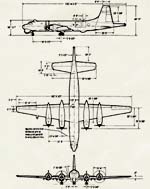 |
 |
| Argus dimensions. |
Argus ground clearances. |
| Click to enlarge. Extracts from EO 05-120A-1, dated
November 1970. (Courtesy of Bill Griffith, VE3WGX) |
GENERAL COMMENTS ABOUT THE ARGUS
Each of those Curtis Wright 3600 BHP engines had three 'power
recovery turbines' - one in each exhaust stack. These were free clutched
to the crankshaft so at cruise power there was little if any power contribution.
At takeoff power setting they were contributed 100 BHP each! They
were lubricated by pumping oil into the bearing, which is why many Argus
photos have large areas of soot all over the engine nacelles and wing.
Even in the days when health-related safety rules were non existent, one
was not allowed in the "mid-rest" area over the wings during takeoffs because
the noise level was above the threshold of pain. Ian Snow lived in
a small apartment in downtown Summerside several miles from the run-up
area at the north end of the runway. He says "In the early morning hours
I had a tea cup that would rattle in it's saucer when the Engineer was
doing his power checks".
An Argus of 405 Maritime Patrol Squadron made history in October 1959
with a 7,355-kilometre non-stop flight from Hawaii to North Bay, Ont. The
endurance record for an Argus is held by 415 Squadron . It was something
like 32 hours and 45 minutes. It was the crew (who had come
back from an operational flight and decided to see just how long they could
stretch it before the fuel gave out. The story was that the engineer dripped
the tanks and there was still more than two hours worth before the a/c
would have reached legal minima thus forcing a landing.
There were 12 stations in each of two bomb bays. All stations could
take the Mk-54 depth charges (normal pattern a stick of 8 charges ideally
at a 45 degree angle to the target's heading). The 4 centre-line
stations could take the Mk-44 torpedo (cloverleaf pattern of 4 around the
target) or 2 Mk 46 per bomb bay due to their length (one torpedo at a time).
The small, flat pane of glass in the forward observer's position was
electrically heated. It became very interesting when St Elmo's fire
would start to dance along the metal straps that held the plastic blister
in place. When the observer's seat was in the "Nose" position the observer
is out in the open. There is a console on the starboard bulkhead
which had the intercom, and a pushbutton for launching "retro". This was
a pneumatic gun that fired a 2.5 inch diameter, 14 inch or so long smoke
marker. It was fired backwards, out of the aft fuselage at 180 knots. Since
the forward speed of the aircraft cancelled out Retro's backward speed,
the marker fell straight down. Also in the vicinity of the console was
a control for the sono homer and an compass card with two pointers.
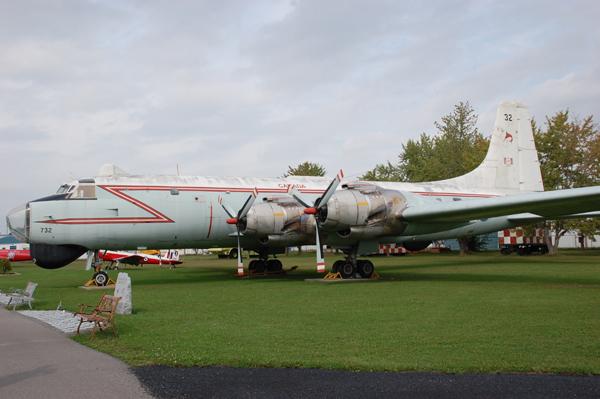 |
| CP-107 Argus Mk 2 #732 on display at the RCAF Museum in Trenton, Ontario
as seen in September 2008. Many antennas have been removed from the lower
aft fuselage so they would not be a safety hazard for visitors. The landing
gear oleo's are also collapsed, otherwise the aircraft would normally
be standing 2 or more feet higher than it is in this picture. Click on
photo to enlarge. This aircraft is fitted with the ASV-21 radar as evidenced
by the smaller chin radome. Photo by Jerry Proc) |
ARGUS COLOURS
The propellor hubs on each of the aircraft in the various Argus
squadrons were painted in differect colours.
| SQUADRON |
HOME BASE |
PROP HUB
COLOUR |
TAIL FLASH |
BADGE |
|
|
|
|
|
| 415 |
Summerside PEI |
Red |
Swordfish |
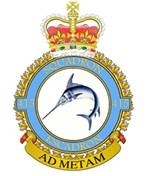 |
| 407 |
? |
Yellow |
Winged trident |
 |
| ? |
? |
Blue |
? |
? |
RADIO CAPABILITIES
With such a huge proliferation of electronics aboard the Argus, and
changing over time, it is very difficult to compile exact fits for particular
eras. The gear listed in the table may NOT have been all fitted simultaneously
but when known, the various pieces of gear of identical function are listed
chronologically.
LOW FREQUENCY BROADCAST
The LF radio receiver was incorporated into the BID-580 device. On the
Argus, a rectangular patch antenna, about 8 or 9 inches by 12 or
so inches and 3/4 to and inch thick was used for LF reception. It was mounted
under the rear fuselage behind the sono tube launcher.
HIGH FREQUENCY COMMS
Early photos of an Argus show a 12" deep, black, painted horizontal
stripe across the tail fin. That was actually an insulator and the
top half of the fin was a "fin cap" antenna which could operate from 2
to 30 MHz . Attached to it was the CU-351 antenna tuner which limited
operation to 20 MHz. The CU-351 was mounted up in the tail and to
it, was attached an ARC 505 (Collins 618T) SSB radio. This was the
primary HF SSB radio.
The Argus also had two long wire antennas that ran from the area of
the props and up to the tail. One of the long wires was attached to a CU-351
tuner and a back-up HF radio installed at the radio position on the starboard
side, just aft of the Flight Engineer's station. That radio was the AN/ARC
38 and was used on CW/AM. It was rumoured that some operators carried
a piece of coax which would allow the ARC 38 radio to be patched to the
fin cap antenna in case the primary radio failed. The second long wire
was used by the Routine Navigator for the Loran 'A' receiver. There was
a Fin Cap/Wire switch at the Routine Nav station for selecting which antenna
to be used for Loran.
Ian Snow, VA3QT, who flew aboard the Argus also reports that: " We had
a crystal controlled aeronautical transceiver on the Argus. I remember
switching boxes mid-Atlantic because the Europeans had a different band
and the frequencies were different. The antenna was a "spike" on
the roof behind the perspex blister on top, just behind the cockpit.
There were two sets of sono-buoy receivers located in the back of the
Argus. The antennas were mounted on the bottom near the sono shoots
and were controlled by the acoustics operator(s) in the back of the aircraft.
The Electronic Surveillance Measures (ESM) system was a combination
of equipment types. It wasn't very good as a wide-band search sensor but
was pretty good for analysis of a target signal. There was a rotating
directional antenna under the aircraft and several band-specific antennas
mounted in long narrow blisters on the aircraft sides.
When I got to the Argus we had a piece of kit called SARAH for DF'ing
243.0 MHz. It had a B(?) scope and two Yagi antennas mounted either
side of the nose. We would con the pilot to turn left/right keeping
the two radio returns balanced on the scope. It was sort of a
<|> presentation. Later, that was replaced by a new piece of kit
that was plugged into the sonobuoy homing system antenna. That antenna
was a rotatable rhombic antenna under the nose and one of the needles on
the compass display was used to present the bearing
In the late 1960's, the Consol navigation system was used occasionally
whenever the navigators couldn't get a Loran or astro (overcast) fix.
Consol operated on the principal of counting Morse dots and dashes.
The navigator only needed an ordinary radio receiver tunable to 300
kHz in order to use the system.. He heard a series of dots slowly merging
into a steady tone and then becoming a series of dashes (or -dashes becoming
dots). He simply had to count how many dots or dashes he could hear before
the steady tone and then plot his position line on a suitably overprinted
map. There were multiple ambiguities in the system since there was no inherent
way of distinguishing between one lobe and another. Out in our operational
areas, the reception was usually poor and the transition from dots
to a steady tone (or vice versa) was very difficult to detect. More
than once, I recall Gord Forbes getting the whole crew to listen to the
transmission, get a count from everybody, and use the average for his position".
VHF/UHF COMMS
ARC-505 VHF
ARC-552 UHF transmitter/receiver fitted.
RATT and CRYPTO
There was RATT and crypto in the Argus. The NESTOR system was a total
disaster After a while, the radio ops discovered that the problem was mostly
due to the narrow bandwidth of the ARC-552 radio. Basically, if you
couldn't see the other aircraft, you couldn't talk to it. The upgrade
to Vinson and the migration to modern radios eventually fixed the situation.
A RATT printer was a relatively small piece of kit about the size of the
typical dot matrix printer of the 80's.
EXTERNAL FEATURES - Click On Image To Enlarge
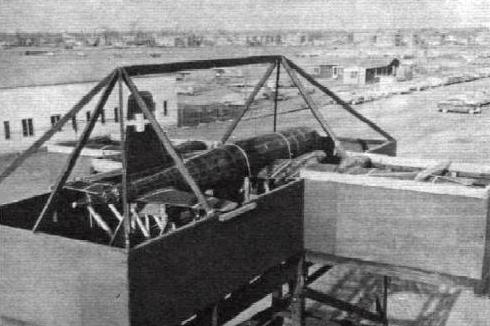 |
| This 1/5th scale model made of wood and covered with copper mesh
was built to assess radio performance particularly the isolated fin aerial.
That's the location of the H.F. aerial which is isolated in the top portion
of the tail. The Argus is said to have had no less than 41 aerials. (Photo
courtesy Flight Archive) |
 |
| This is how the fin antenna was implemented. The black portion is an
insulator. (Photo from Sentinel Magazine, May 1968) |
SOME ADDITIONAL NOTES ABOUT THE EQUIPMENT
AN/APS-20
The APS-20 duplexer was interesting. It sat on top of the antenna
unit. The horizontal piece to the right of the curved waveguide had
20 or so crystal rods tuned to the radar frequency. There was a waveguide
from the transmitter that was horizontally polarized which would
blast the transmit pulse right through the crystals and out the antenna.
The much weaker reflected signal would be rotated 90 degrees by the crystals
and depart via a vertically polarized waveguide to the receiver.
This technique allowed for a significant degree of isolation between the
transmitter and receiver.
In APS-20E display photo, the four large knobs were used for adjusting
the placement of the PPI origin and the origin of the cursor. It
was possible to scale the presentation down to a very small area and by
offsetting the PPI origin the operator could get a very detailed look at
the returned target of interest. This was very useful for getting
an accurate fix from a point of land or decoding the IFF returns.
The ability to offset the cursor origin meant that one could easily do
homings to a point offset from some reference point . An example of this
would be to drop a sono at a certain range and bearing from a ship for
example.
The Argus has two "LDG" compass systems. These were a variant
of the J2 gyro and were the epitome of that technology era. When
the Argus flew into an area of magnetic uncertainty (such as Arctic patrols)
the navs would put the gyro into grid mode; i.e. the gyro was pointed into
free space and left to run rather than try to torque it to maintain magnetic
north or true north. At some point the convergence of the longitude
lines or the angle rate to Mag north becomes too great to torque the gyro
reliably. (One time, navigator Gord Forbes set up a grid trip from
Summerside PEI to Roosevelt Roads [2] Puerto Rico. Since Rosy
is almost dead south of Summerside, he set the gyro so the compass card
read due north. Nothing like messing with the pilot's minds for a
little light entertainment).
Sonobuoys operate in the band 162 to 174 MHz. They transmit in FM with
a +/- 105 KHz deviation, This wide band deviation is necessary to obtain
the great dynamic range (46 db) of the sonobuoy listening system.
OTHER INFORMATION
Chris Charland recalls that the Radio Officer's position
was located on the starboard side behind the Flight Engineers position.
The R/O sat across from the Routine Navigator (port side). You got a nice
view of No. 3 engine. It was the only crew position seat that faced
backwards on the Argus. All others were forward or side facing. The
Beam Lookout positions seats were on tracks allowing the movement forwards
and backwards. The seat also could swivel.
The term 'Radio Op' is a misnomer. The aircrew position was actually
that of Radio Officer. This aircrew position was eliminated in late 1960s.
Most R/Os who chose to stay in the Air Force were cross-trained either
as pilots or navigators. As a result of the elimination of
the aircrew position, the enlisted position of 'Observer' was formed".
Dave Fletcher says "We had two ARC-38 transceivers initially and then
replaced one with a Collins ARC-505 SSB set. We had the portable KL-7 encryption
device, which was positioned in the open space to the left of the keyboard
in the photo".
Dave Nimmo, VE1NN, reports that "in the mid 1960's, one of the
ARC-38s was replaced with a Collins 618T which was 100 watts on CW, AM,
SSB, and Data. That was our introduction to SSB and the start of the trickle
of gear which led to the capability of having on-line encryption. The 618T
was not a popular replacement in our radio suite at the time because
it did not have full break-in plus there was no control/adjustment
for receiver pitch (no BFO). It was not as friendly on CW as the ARC-38
was. You might as well say it was useless on CW because of the way we used
"break-in" on military radio circuits".
Ian Snow recalls an Argus test aircraft. "Argus #729 was the Maritime
Proving and Evaluation Unit's aircraft and had a lot of one-off equipment
installed. One was and ILS system and the antenna was perched up
over the pilots just as you'd expect. The SARAH antennas were still
on it -- a two element yagi, vertically polarized, mounted just below and
behind the pilot's windows.
I remember when MP&EU was conducting a trial of an early Litton
inertial navigation platform. They flew from Summerside (P.E.I.)
to Valkenburg in the Netherlands and wrote a letter to Litton about how
they were so impressed with an error of only 1.5 nm on landing. Litton
wrote back asking where they parked the aircraft, and pointed out that
the published coordinates in the GPH 206 where some 1.5 nm away from where
they'd parked. The actual error was something much, much less."
The Argus was involved in two fatal crashes, both in March, 12 years
apart. Just before midnight, March 23, 1965, during night training on anti-submarine
warfare exercises 95 kilometres north of Puerto Rico, an Argus of 404 Squadron
flew over HMS Alcide. Then submariners saw the glow of a crash reflected
in the sky. All 15 crew and one scientific advisor aboard were killed.
No official explanation of the crash was given.
Twelve years later, March 31, 1977, a 415 Squadron Argus developed engine
problems and had to shut down one engine about 650 kilometres out and head
for an emergency landing at CFB Summerside, P.E.I., arriving in a thunderstorm.
The pilot was a local who tried to avoid the control tower and the school
behind it. He veered downwind and lost height, hit a snowbank and lost
another engine. The pilot tried to get aloft, but hit an aircraft sitting
on the ground, and began spilling fuel, which ignited. A ball of fire followed
the Argus, which landed on its belly and split open. The survivors escaped
through this opening. Three of the 16 crew were killed and 11 were injured.
STORIES
From a submitter who wishes to remain anonymous:
"It was a normal dark damp morning in the early 60’s, in the middle
of a typical Annapolis Valley Winter as we lumbered down the runway to
the distinctive heavy roar of the Argus under wet power. We made sure the
high powered APS-20 radar was left on standby as the wheels cranked up
into the wells…. no point in having the manager of the Kingston CIBC bank
make yet another early morning trip into the branch. Both he and the local
RCMP were starting to lose their sense of humour, having the two megawatts
peak power of the APS-20 yet again tripping the security system at the
bank. We were heavy and full of fuel with loaded bomb bays.
We had been tasked via a “green” from Maritime Command Headquarters. This
was one of 10 or 12 trips per month, designated to carry a full weapons
load. We briefed at 0400 hours for the normal 18 hour “green”…take off
at 0600 hours, over Omega and On Task at sunrise.
As a communicator and amateur radio operator I was looking forward to
this trip. We had just started the Argus communications upgrade program,
replacing one of the two Collins ARC-38 HF transceivers (CW and AM only)
with a Collins 618T giving us the added capabilities of radio-teletype
and single sideband. This aircraft had one of the first 618Ts to
be installed. Once we were settled in to the routine of the flight, I set
up watch with Halifax Military on CW while I played with the 618T on single
sideband (SSB). SSB was relatively new to the air world but we amateurs
had been using it for some time to give us vastly improved ranges on voice
transmissions.
The 618T receiver was both sensitive and selective. Where could
I go to try it out? Halifax Military had already given me a “Loud
and clear” on SSB. I tuned down into the middle of the 20-meter amateur
phone band. Lots of signals, from all over, the band was open. Tuning
14.180 kHz, the bottom of the 20-meter “DX window” I heard a very strong
UA3 calling “CQ North Africa” using SSB. I went back to him using
my VE1xx amateur call, (identifying me only as a Canadian amateur located
somewhere in the Maritime Provinces).
I apologized for calling him (as he was looking for North Africa) but
lied, saying I had just put up a new antenna and could he give me a quick
signal check! “No problem Gary,” he says and tells me I am “Loud
and Clear.” He congratulated me on my new antenna and told me he was about
8 kilometers north of city center in Moscow!
I quickly thanked him for the signal check and departed the frequency.
I was shaking a little as I realized I had just communicated directly with
Moscow while out on an operational patrol in the middle of the cold
war and sitting on top of a whole bunch of weapons, supposedly with
“Ivan’s” name on them!
About an hour later the skipper asks me how the new radio is working.
Hmmm…. will he understand?…I go for it…”Pretty good” says I, “we’re loud
and clear on the two radio checks I’ve done…. one with Halifax Military
and one with Moscow!”
Argus engines weren't quiet, but the silence from the cockpit was deafening…pilots
never did have much of a sense of humour".
END OF LIFE
The last Argus flight occurred on 10 November 1980 by an aircraft from
405 Squadron thus bringing to a close, the long history of the "Venerable
Argus". The "birds" that were scrapped were stripped clean and when flown
from Greenwood to Summerside (for interim storage and the site of the actual
scrapping) the pilots were flying visually and had a radio package on a
piece of plywood strapped down to the floor.
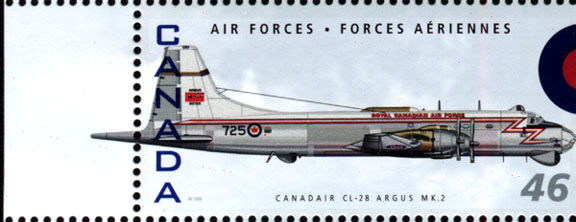 |
| In 1999, Canada Post issued a series of stamps featuring Canadian aircraft.
The Argus was one of them. (Image provided by Bert Campbell). |
Ian Snow recals the end of an era. "My own "last story" revolves
around the Shearwater Colours Parade and Squadrons HT406, HS443, HS423
and VU-32. The fifth Sqn - MR880 - had moved to Summerside PEI by
the time. I was the Escort Officer who brought the 443 colour from NDHQ
to Shearwater before the ceremony. since MP415 was ensconced at Greenwood.
There was a mass parade including a planned flypast of several aircraft
flown out of Shearwater over the years. At that point most of the
Greenwood Argus had been stripped of whatever was being salvaged and had
been flown to Summerside for disposal. It was generally understood
on the rumour mill that they were pretty much down to the last Argus.
The parade was fantastic, and the flypast was underway. But oh,
off in the distance, was the faint whisper of a sound only an Argus crewmember
would recognize -- a powered climb. Quietly, and I'm sure all of
us ex-Argus folks were praying that the ZX crew would do what any red-blooded
air force type would do. Faintly the old girl continued to climb
and the bearing was shifting right as she headed eastward somewhere north
of Halifax International airport. The bearing steadied and I'm sure I wasn't
the only one who began pondering how far I could turn my head without making
it obvious. The old girl was definitely approaching, the engines
were still at full power and a few guests in the bleachers were beginning
to recognize the sound and were looking for the aircraft. Closer,
and now distinctly audible, the excitement began to build in the ranks;
where was it, would it overfly, how fast, how low? The engine noise
continued to build; no doubt about it, this one was going to be fast and
low. IT WAS. One pass down the east side of the inner ramp
just behind the parade, minimum altitude, maximum speed, finishing with
a full-power climb. And off they went to Summerside. Never knew who
the pilots and FE were, or even the side number."
FOOTNOTES:
[1] Dripping- A fuel measuring system on the Argus was a tube that extended
from the bottom of the wing up through to the top of the fuel tank.
The Flight Engineer would lower the tube until fuel spilled over the top
(only an ounce or so), indicating the fuel level in the tank.
[2] Roosevelt Roads Naval Station acquired the sobriquet of "Roosey"
pronounced as "Rosy".
[3] By Bert Campbell
[4] The widely publicised 148,000 lbs was in the initial press releases.
It is confirmed that between 1963 to1979, it was 157,000 pounds.
ACKNOWLEDGMENTS
The webmaster's gratitude is extended to Ian R. Snow RCAF/CF Ret'd who
provided much of the material which appears in this document and ample
guidance with its development. Acknowledgments are also extended to Bert
Campbell and Bryan Nelson of the Greenwood Aviation Museum for their assistance.
.
Credits and References:
1) RCAF.com http://rcaf.com/aircraft/patrol/argusmp/index.php
2) Ian Snow RCAF/CF retired.<va3qt-4(at)sympatico.ca>
3) Flight Archive http://www.flightglobal.com/pdfarchive/view/1957/1957%20-%201454.html
4) Greenwood Military Aviation Museum http://www.gmam.ca/argus.htm
5) http://en.wikipedia.org/wiki/Canadair_CL-28
6) Mark 1 vs Mk 2 http://www.airforce.forces.gc.ca/site/equip/historical/arguslst_e.asp
7) Mac's Naval Photography http://macsnavylinks.ca
8) http://www.airforce.forces.gc.ca/12w-12e/sqns-escs/page-eng.asp?id=472
9) Bill Griffith VE3WGX <ve3wgx2(at)sympatico.ca>
10) Bert Campbell <navigator1(at)eastlink.ca> 5,000
Argus Hours - Radio Officer/Navigator
11) Bryan Nelson, Greenwood Military Aviation Museum.
<gmam001(at)hotmail.com>
12) Extracts from EO 05-120A-1, dated November
1970.
13) Paul Muller <paul(at)p2vneptune.com>
14) http://www.flightglobal.com/pdfarchive/view/1959/1959%20-%203164.html
15) David C. Fletcher <dcf(at)mars.ark.com>
16) Argus fatalities https://legionmagazine.com/en/2019/03/rcaf-welcomes-the-argus/
Back to Table of Contents
Mar 28/19







